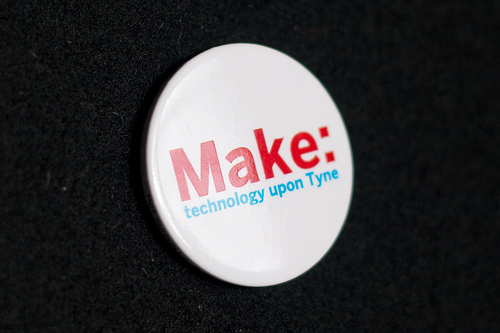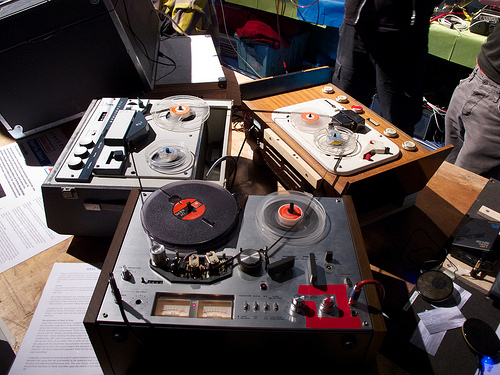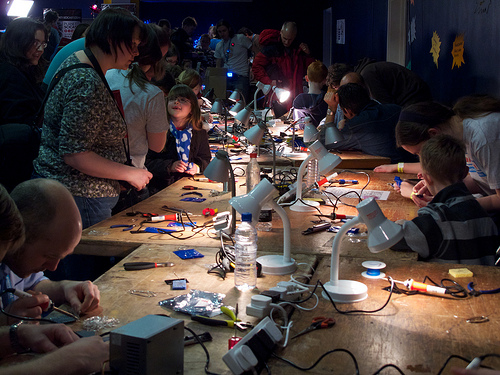Maker Faire UK
I’ve been back from Maker Faire in Newcastle for a couple of days now. My brain is just about back to normal. Maker Faire is an exhibition, (un)conference, and general get-together of people who are interested in making stuff: craft, DIY, hackable electronics and software, art projects, science projects, robots, knitting and everything in between.
This post is an attempt to collect together some of the most interesting things I saw; give me an excuse to dig around the net looking up people’s projects; and immerse myself in it for a while so I can start to make sense of it all. So, in no particular order, my highlights:
Hack(er)spaces
I was very happy to see Mitch Altman talk about hackspaces, why they’re important and exciting, and why you should start one. He shared some of his experiences at Noisebridge, San Fransisco and what other hackspaces have learned. Some simple ideas that resonated with me:
- Publicity: everyone loves stickers. And they’re great for covering up the corporate logos on laptops
- Radical openness: hand out keys to everyone. I’ve got mine; what a great excuse to go to San Fransisco
- Physical community: it’s important to have a physical space where people can come together and function as a community. Ideally cook and eat together too.
- Diversity breeds diversity: so you don’t want your hackspace to be a place just for electronics geeks to hang out? Invite some sewing geeks, or cooking geeks. It might feel artificial at first, but soon enough the presence of those people will attract other diverse people and diversity will become the norm. And of course diversity lays the groundwork for creative cross-pollination
Mitch is an inspiring speaker and advocate; it’s the first time in 10 years or so that I’ve seen that Californian, utopian, techno-punk attitude expressed so clearly and convincingly. It reminded me of the best parts of Mondo 2000 and Immediatism. Maybe the shallow, consumerist, business-as-usual techno lifestyle promulgated by Wired et al has had it’s day, and the pendulum is swinging back to the underground. I hope so.
Arduino
I’m just getting into the delights of this accessible open-source micro-controller. I know that for many makers, Arduino is old hat, but hey, the cutting edge is in a different place for everyone. It was great to meet the Oomlout guys; I’m most likely going to shell out for their highly recommended starter kit.
Low-cost fabrication
Again, old hat for some, but an exciting new world for me. There were three or four tables with desktop 3D printers on show. Interesting to see them in the flesh, but I wasn’t that impressed with the quality of the output.
For me, the sweet spot appears to be in bespoke, remote fabrication: send your 3D or vector file to a specialist fabricator, and get your component back in a few days or weeks. Still low cost, not as instant as desktop fab, but much higher quality and a greater variety of materials.
I spoke with Euphy on the Shapeways stall, who was shwing some of his beautiful fabricated jewellery. I had been thinking of prototyping a one-piece version of my stove using their Alumide or Stainless Steel processes. Unfortunately, it looks like that isn’t going to work.
OpenThing were showing off some of their open-source products, with designs online and free for others to make and hack. They recommended Ponoko‘s online laser-cutting service for making acrylic components. Perfect for my planned Arduino synth and DIY continuous lighting rig.
And London Hackspace were out in full force. I think I just about persuaded them to let me come up and use their laser cutter.
Tangible electronics and tactile musical devices
Speaking of synths, Hackable Devices had a pretty sweet synth in an acrylic box. Not for me, because I want to make my own first, but food for thought, nonetheless.
I was more inspired by Lewis Sykes of Monomatic, talking about his Modular Music Box housed in a set of lovely wooden boxes, inspired by the Monome controller.
Nu Desine were showing off their AlphaSphere, a globe with tactile rubber pads that the player can use to control the sound. They’re crowd-funding its development through Indiegogo, so go check it out.
Cefn Hoile had very different kinds of physical manifestations of electronics. An hourglass with embedded screen that let you play out the seven ages of man with exactly the kind of intricate physics model that Shakespeare would have specified. He also demoed the Perfect Hindsight Machine, a device with one simple dial enabling the user to travel to any point in time as far back as 1894.
His cohort in the Curiosity Collective, Mike Challis, also showed the Reel to Reel, an alaogue sampling and delay machine that I spent far too long playing with. Delay is cool.
The Brighton Massive
A few Brightonians braved the grim northern weather, including Nick Sayers, who gave a talk on his adventures making geodesic domes out of estate agent boards and other unusual materials. I was pleasantly surprised by the depth of his project. He had a lot to say, and it was all interesting.
Emily Toop was up representing BuildBrighton, as was Ian Ozsvald. They had an emotionally over-sensitive, face-tracking robot, amongst other things. It was great to see a Brighton presence, and next year we will have to make sure we step it up a level.
Knithacking
As a new convert to sewing, I particularly enjoyed some of the fabric-based projects. The Chinchilla was showing both handmade books and a variety of knitted animals and sewn felt bats. The animals were originally things she had created as decorations for her book stalls at artists’ book fairs, but had become a popular product in their own right.
LEDs were refreshingly absent at Knit a Neuron. And Rainycatz united electronics and fabric with a wearable noughts and crosses game, powered by conductive velcro and the sewable LilyPad Arduino.
Pinhole Photography
Justin Quinnell gave an intgriguing talk about pinhole photography and the beer can cameras he uses to take ultra-long exposures (i.e. six months) that track the movement of the sun across the sky. We made our own cameras on his stall and we’re now plotting where to place them for the next six months. He also introduced us to Tarja Trygg, whose Solargraphy project aims to ‘create pinhole solargraphs all over the world and build a World Map of Solargraphs’
Child’s Play
There were a lot of kids, which was great in one sense, but it would have been interesting to have had maybe an evening session where people could relax with a beer in a slightly less frenetic environment; and discuss projects in more depth.
Having said that, watching the kids play with soldering irons, talk to Daleks, or just look at all the cool projects people had made, was very inspiring. In particular, they seemed to take to Jam Jar Collective’s Friispray digital graffiti system with ease.
Jam Jar Collective were one of many groups experimenting with making beyond a hobby context. Whether it’s teaching and running workshops, touring with art installations or selling electronics kits, there were lots of ideas here that blurred the boundaries between work and play, which is exactly as it should be.



